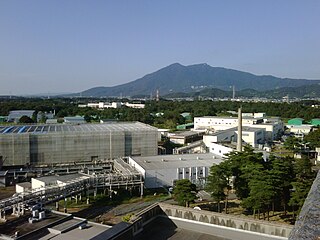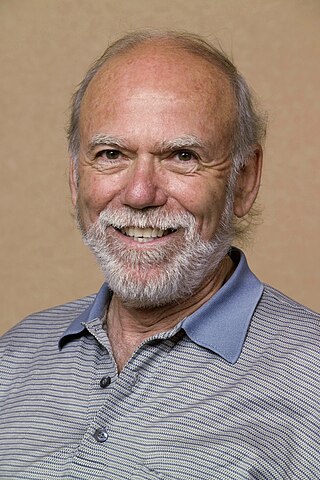Related Research Articles

The European Organization for Nuclear Research, known as CERN, is an intergovernmental organization that operates the largest particle physics laboratory in the world. Established in 1954, it is based in Meyrin, western suburb of Geneva, on the France–Switzerland border. It comprises 23 member states. Israel, admitted in 2013, is the only non-European full member. CERN is an official United Nations General Assembly observer.

SLAC National Accelerator Laboratory, originally named the Stanford Linear Accelerator Center, is a federally funded research and development center in Menlo Park, California, United States. Founded in 1962, the laboratory is now sponsored by the United States Department of Energy and administrated by Stanford University. It is the site of the Stanford Linear Accelerator, a 3.2 kilometer (2-mile) linear accelerator constructed in 1966 that could accelerate electrons to energies of 50 GeV.

Fermi National Accelerator Laboratory (Fermilab), located in Batavia, Illinois, near Chicago, is a United States Department of Energy national laboratory specializing in high-energy particle physics.

A linear particle accelerator is a type of particle accelerator that accelerates charged subatomic particles or ions to a high speed by subjecting them to a series of oscillating electric potentials along a linear beamline. The principles for such machines were proposed by Gustav Ising in 1924, while the first machine that worked was constructed by Rolf Widerøe in 1928 at the RWTH Aachen University. Linacs have many applications: they generate X-rays and high energy electrons for medicinal purposes in radiation therapy, serve as particle injectors for higher-energy accelerators, and are used directly to achieve the highest kinetic energy for light particles for particle physics.
A collider is a type of particle accelerator that brings two opposing particle beams together such that the particles collide. Colliders may either be ring accelerators or linear accelerators.

A synchrotron is a particular type of cyclic particle accelerator, descended from the cyclotron, in which the accelerating particle beam travels around a fixed closed-loop path. The magnetic field which bends the particle beam into its closed path increases with time during the accelerating process, being synchronized to the increasing kinetic energy of the particles. The synchrotron is one of the first accelerator concepts to enable the construction of large-scale facilities, since bending, beam focusing and acceleration can be separated into different components. The most powerful modern particle accelerators use versions of the synchrotron design. The largest synchrotron-type accelerator, also the largest particle accelerator in the world, is the 27-kilometre-circumference (17 mi) Large Hadron Collider (LHC) near Geneva, Switzerland, built in 2008 by the European Organization for Nuclear Research (CERN). It can accelerate beams of protons to an energy of 7 tera electronvolts (TeV or 1012 eV).

The International Linear Collider (ILC) is a proposed linear particle accelerator. It is planned to have a collision energy of 500 GeV initially, with the possibility for a later upgrade to 1000 GeV (1 TeV). Although early proposed locations for the ILC were Japan, Europe (CERN) and the USA (Fermilab), the Kitakami highland in the Iwate prefecture of northern Japan has been the focus of ILC design efforts since 2013. The Japanese government is willing to contribute half of the costs, according to the coordinator of study for detectors at the ILC.

The High Energy Accelerator Research Organization, known as KEK, is a Japanese organization whose purpose is to operate the largest particle physics laboratory in Japan, situated in Tsukuba, Ibaraki prefecture. It was established in 1997. The term "KEK" is also used to refer to the laboratory itself, which employs approximately 695 employees. KEK's main function is to provide the particle accelerators and other infrastructure needed for high-energy physics, material science, structural biology, radiation science, computing science, nuclear transmutation and so on. Numerous experiments have been constructed at KEK by the internal and international collaborations that have made use of them. Makoto Kobayashi, emeritus professor at KEK, is known globally for his work on CP-violation, and was awarded the 2008 Nobel Prize in Physics.

The Cornell Laboratory for Accelerator-based ScienceS and Education (CLASSE) is a particle accelerator facility located in Wilson Laboratory on the Cornell University campus in Ithaca, NY. CLASSE was formed by merging the Cornell High-Energy Synchrotron Source (CHESS) and the Laboratory for Elementary-Particle Physics (LEPP) in July 2006. Nigel Lockyer is the Director of CLASSE in spring of 2023.
The Accelerator Test Facility (KEK-ATF) is a test accelerator in the KEK laboratory in Tsukuba, Japan. It is a test bed for production of the beam for the proposed International Linear Collider (ILC) linear electron-positron collider. Its main goal is to create the super-low-emittance beam which is needed for the ILC.
FLASH, acronym of Free Electron LASer in Hamburg, is a superconducting particle accelerator-based soft X-ray free-electron laser located at the German national laboratory DESY in Hamburg, Germany. It can generate very powerful, ultrashort pulses (~10−14 s) of coherent radiation in the energy range from 10 eV (electronvolt) to 300 eV. It started operation for external users in the year 2005 and is used for surface, molecular and atomic physics experiments. Intended applications are also the imaging of single biological complex molecules with time resolution.

A particle accelerator is a machine that uses electromagnetic fields to propel charged particles to very high speeds and energies, and to contain them in well-defined beams. Large accelerators are used for fundamental research in particle physics. Accelerators are also used as synchrotron light sources for the study of condensed matter physics. Smaller particle accelerators are used in a wide variety of applications, including particle therapy for oncological purposes, radioisotope production for medical diagnostics, ion implanters for the manufacture of semiconductors, and accelerator mass spectrometers for measurements of rare isotopes such as radiocarbon.
A Fixed-Field alternating gradient Accelerator is a circular particle accelerator concept that can be characterized by its time-independent magnetic fields and the use of alternating gradient strong focusing.

Barry Clark Barish is an American experimental physicist and Nobel Laureate. He is a Linde Professor of Physics, emeritus at California Institute of Technology and a leading expert on gravitational waves.
Paul Heinrich Söding is a German physicist. He is best known for his work in particle physics and as former director of research of the German particle physics lab DESY.

The Future Circular Collider (FCC) is a proposed particle accelerator with an energy significantly above that of previous circular colliders, such as the Super Proton Synchrotron, the Tevatron, and the Large Hadron Collider (LHC). The FCC project is considering three scenarios for collision types: FCC-hh, for hadron-hadron collisions, including proton-proton and heavy ion collisions, FCC-ee, for electron-positron collisions, and FCC-eh, for electron-hadron collisions.
The Linear Collider Collaboration (LCC) is an organization designated by the International Committee for Future Accelerators (ICFA) to coordinate global research and development efforts for two next-generation particle physics colliders: the International Linear Collider (ILC) and the Compact Linear Collider (CLIC). The mission of the LCC is to facilitate decisions that the next collider "will be built, and where". Members of the collaboration include approximately 2000 accelerator and particle physicists, engineers and other scientists.
Paul Dutton Grannis is an American physicist.
Nan Phinney is a retired American accelerator physicist at SLAC. She was program coordinator for the Stanford Linear Collider (SLC), the world's first linear collider. Her research interests are high energy colliders and linear colliders. She became an American Physical Society Fellow in 1993. Her last job title at SLAC was "Distinguished Staff Scientist".
A Higgs factory is a particle accelerator designed to produce Higgs bosons at a very high rate, allowing precision studies of this particle. A Higgs factory was identified as the highest future priority of particle physics in the 2020 European Strategy Report. This view was reaffirmed in 2022 by the International Committee on Future Accelerators.
References
- ↑ "Memorandum of Understanding for Linear Collider Collaboration" (PDF). Fermi National Accelerator Laboratory. 17 December 2013. Archived (PDF) from the original on 1 December 2016. Retrieved 13 December 2016.
- 1 2 "ILC - Global Design Effort". www.linearcollider.org. 2013. Archived from the original on 2 July 2013. Retrieved 14 December 2016.